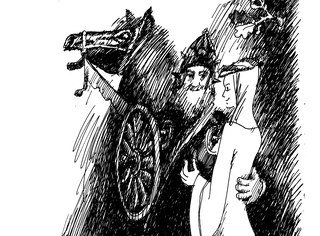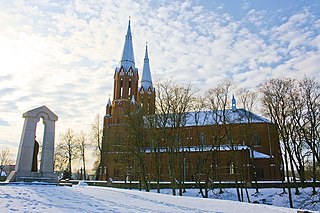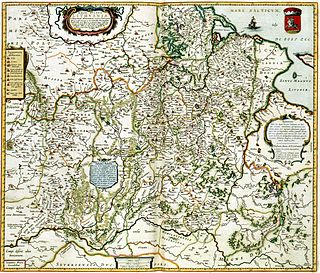Related Research Articles

Morta was wife of Mindaugas, the first known ruler of the Grand Duchy of Lithuania. She was the Grand Duchess consort of Lithuania and later Queen consort of Lithuania (1253–1262). Very little is known about her life. Probably, Morta was Mindaugas' second wife as Vaišvilkas, the eldest son of Mindaugas, was already a mature man active in international politics when Morta's sons were still young and dependent on the parents. After her death, Mindaugas married her sister, the wife of Daumantas. In revenge, Daumantas allied with Treniota and assassinated Mindaugas and two of Morta's sons in 1263.

The Battle of Saule was fought on 22 September 1236, between the Livonian Brothers of the Sword and pagan troops of Samogitians and Semigallians. Between 48 and 60 knights were killed, including the Livonian Master, Volkwin. It was the earliest large-scale defeat suffered by the orders in Baltic lands. The Sword-Brothers, the first Catholic military order established in the Baltic lands, was soundly defeated and its remnants accepted incorporation into the Teutonic Order in 1237. The battle inspired rebellions among the Curonians, Semigallians, Selonians, Oeselians, tribes previously conquered by the Sword-Brothers. Some thirty years' worth of conquests on the left bank of Daugava were lost. To commemorate the battle, in 2000 the Lithuanian and Latvian parliaments declared 22 September to be the Baltic Unity Day.

Pilėnai was a hill fort in the Grand Duchy of Lithuania. Its location is unknown and is subject to academic debates, but it is well known in the history of Lithuania due to its heroic defense against the Teutonic Order in 1336. Attacked by a large Teutonic force, the fortress, commanded by Duke Margiris, tried in vain to organize a defense against the larger and stronger invader. Losing hope, the defenders decided to burn their property and commit mass suicide to deprive the Order of prisoners and loot. This dramatic episode from the Lithuanian Crusade has caught the public imagination, inspired many works of fiction, and became a symbol of Lithuanian struggles and resistance.
Voruta may have been the capital city of the Grand Duchy of Lithuania and the Kingdom of Lithuania during the reign of king Mindaugas in the 13th century. Voruta is mentioned briefly in a written source only once and its exact location is unknown. Despite all the uncertainties, the concept of Voruta is well-known and popular in Lithuania.
Žvelgaitis was a Lithuanian duke who died in 1205. He is the first Lithuanian duke whose name is known from reliable sources. The account of his expedition and death is given by Henry of Livonia, an early thirteenth-century German chronicler of Latvian history, spanning the years 1186-1227. Žvelgaitis is called "rich and powerful," but he was not the supreme duke, as he led the army in the name of another, more powerful duke.
Dausprungas was the older brother of Mindaugas, the first King of Lithuania. Dausprungas is mentioned in the peace treaty with Galicia–Volhynia in 1219 among the 21 early dukes of Lithuania as one of the five elder dukes, the other four being Živinbudas, Daujotas, Mindaugas and Viligaila. Since Dausprungas is the only known brother of Mindaugas, Mindaugas' nephews Edivydas and Tautvilas are presumed to be his sons. If that is true, then Dausprungas is father-in-law of Daniel of Halych and he was also married to Vykintas' sister. Because it is known that Mindaugas used to kill his relatives to gain power and because Dausprungas is not mentioned in any other sources, some imply that he was killed by Mindaugas, but others rebut since his sons still ruled their lands in 1248.

Ryngold or Ringaudas was a mythological Grand Duke of Lithuania from the Palemonids legends and supposed father of Mindaugas, the first King of Lithuania (1251–1263). In fact, there is nothing known about Mindaugas' father from reliable sources. The Livonian Rhymed Chronicle, a contemporary source, just mentions that he was a powerful duke, but does not provide his name.
Stekšys was a duke of Lithuania, killed in 1214 near Lielvārde during an attack against Livonia. He is one of the earliest mentioned Lithuanian dukes. He succeeded duke Daugirutis, who killed himself while in Livonian captivity in 1213. After these two deaths, Lithuanian raids to the Livonian lands decreased in frequency and historians assume a period of decline in the unification process of the Baltic tribes.

Antanas Baranauskas was a Lithuanian poet, mathematician and Catholic bishop of Sejny. Baranauskas is best known as the author of the Lithuanian poem Anykščių šilelis. He used various pseudonyms, including A.B., Bangputys, Jurksztas Smalaūsis, Jurkštas Smalaūsis, and Baronas. He also wrote poetry in Polish.

Anykščiai is a ski resort town in Lithuania, 20 miles west of Utena. The Roman Catholic Church of St. Matthias in Anykščiai is the tallest church in Lithuania, with spires measuring 79 metres in height. Anykščiai has a resort status in Lithuania and is a popular destination of a domestic tourism.

Upytė is a small village in Panevėžys district municipality in northern Lithuania. It is situated some 12 km southwest of Panevėžys on the banks of Vešeta Creek. It is now the capital of an elderate. In 1987 it had 580 residents. In the Lithuanian language, Upytė is a diminutive form of the word upė, which means river.

Tomas Baranauskas is a Lithuanian historian specializing in the history of medieval Lithuania. He is the author of the book The Formation of the Lithuanian State.
Živinbudas was one of the five senior Lithuanian dukes mentioned in the treaty with Halych-Volhynia in 1219. The treaty lists a total of 21 dukes, five of them being elder or superior. Since Živinbudas is mentioned first in the list, it is presumed that he was the supreme ruler of Lithuania. He is not mentioned in any other sources and the mention in the treaty is the only bit of information available about him. However, some historians argue he was ancestor of Traidenis, Grand Duke of Lithuania ca. 1270-1282. That is probably influence of the Palemonids legends popularized by fake 16th century genealogies that connected a mythical Palemon, a prince of Venice who settled in Lithuania in the 10th century, to the Gediminids, an established dynasty.
Daujotas was one of the 5 elder Lithuanian dukes mentioned in the peace treaty with Halych-Volhynia in 1219. In the same document Vilikaila is mentioned as brother of Daujotas which suggests that Daujotas was the older or perhaps more influential brother. The brothers are not mentioned in any other sources. Tomas Baranauskas, a modern Lithuanian historian, believes that Vilikaila and Daujotas might be sons of Stekšys, a Lithuanian duke killed in 1214.
The House of Mindaugas was the first royal family of Grand Duchy of Lithuania, centered on Mindaugas, the first known and undoubted sovereign of Lithuania. He was crowned as King of Lithuania in 1253 and assassinated ten years later. His known family relations end with children; there is no data on his great-grandchildren or any relations with the Gediminids, a dynasty of sovereigns of Lithuania and Poland that started with Butigeidis ca. 1285 and ended with Sigismund II Augustus in 1572.

The family of Gediminas is a group of family members of Gediminas, Grand Duke of Lithuania, who interacted in the 14th century. The family included the siblings, children, and grandchildren of the Grand Duke and played the pivotal role in the history of Lithuania for the period as the Lithuanian nobility had not yet acquired its influence. Gediminas was also the forefather of the Gediminid dynasty, which ruled the Grand Duchy of Lithuania from 1310s or 1280s to 1572.
The Union of Kraków and Vilna also known as Union of Vilnius was one of the agreements of the Polish–Lithuanian union. It was signed in Kraków by Polish nobility on 6 May 1499 and in Vilnius by Lithuanian nobility on 24 July 1499.

Mindaugas is the first known Grand Duke of Lithuania and the only crowned King of Lithuania. Little is known of his origins, early life, or rise to power; he is mentioned in a 1219 treaty as an elder duke, and in 1236 as the leader of all the Lithuanians. The contemporary and modern sources discussing his ascent mention strategic marriages along with banishment or murder of his rivals. He extended his domain into regions southeast of Lithuania proper during the 1230s and 1240s. In 1250 or 1251, during the course of internal power struggles, he was baptised as a Roman Catholic; this action enabled him to establish an alliance with the Livonian Order, a long-standing antagonist of the Lithuanians. During the summer of 1253 he was crowned King of Lithuania, ruling between 300,000 and 400,000 subjects.

The history of Lithuania between 1219 and 1295 concerns the establishment and early history of the first Lithuanian state, the Grand Duchy of Lithuania. The beginning of the 13th century marks the end of the prehistory of Lithuania. From this point on the history of Lithuania is recorded in chronicles, treaties, and other written documents. In 1219, 21 Lithuanian dukes signed a peace treaty with Galicia–Volhynia. This event is widely accepted as the first proof that the Baltic tribes were uniting and consolidating. Despite continuous warfare with two Christian orders, the Livonian Order and the Teutonic Knights, the Grand Duchy of Lithuania was established and gained some control over the lands of Black Ruthenia, Polatsk, Minsk, and other territories east of modern-day Lithuania that had become weak and vulnerable after the collapse of Kievan Rus'.
References
- 1 2 3 4 Baranauskas, Tomas. "Viligaila". Universal Lithuanian Encyclopedia (in Lithuanian). Retrieved 18 July 2021.
- Baranauskas, Tomas. "Brandieji viduramžiai: II dalis (1183-1283 m.)". Chronologija (in Lithuanian). Lietuvos.net. Archived from the original on 2006-12-25. Retrieved 2006-12-29.